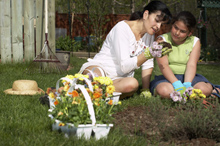15 Tips to Get Your Yard Ready for Spring
by www.SixWise.com
Spring is definitely in the air, but winter has likely left your yard a work-in-progress. Last year’s dried up perennials, a patchy lawn, overgrown trees and shrubs … all are common sights at the start of the season. But with a bit of care and effort on your part, you can get your yard back in shape and be ready to enjoy the season as soon as the warm weather arrives.

By doing a little spring-cleaning in your yard now, you’ll help your garden thrive all season. |
In Your Garden
- If you didn’t do so in the fall, trim back any perennials, including ornamental grasses, before they start to grow. The leaves and stalks should be cut close to ground level. Avoid pulling or yanking out stems, as this may break emerging shoots.
- Pull back extra winter mulch from planting beds using a hand-rake or a long-handled rake. This allows earlier warming of the soil. Ideally, remove mulch on a cloudy day to prevent newly emerged plants from getting sunburned. (Later in the spring you can add a new layer of mulch to control weeds and help the soil retain moisture.)
- Add a slow-release, organic fertilizer around perennials, bulbs and roses, then cover it with a new layer of mulch (2-4 inches thick) to promote healthy growth.
- Check your soil for dampness. You should only begin digging and planting when the soil is dry (dry enough to crumble apart in your hand), as digging in wet soil can degrade its structure.
- Remove weeds as you see them begin to grow. By staying on top of weeding now, you’ll save yourself a lot of trouble later (plus the roots are shallow now and easier to pull out).
Keep Pests Safely Away
From Your Garden

As soon as the weather gets warmer, insect pests come back with a vengeance. Flea 'n Tick B Gone is an all-natural, completely non-toxic insect repellant that will keep pests -- including fleas, ticks, ants, spiders, bees, flies and more -- away from your garden. Simply mist the area prior to working outside, and you can garden in peace (and free of pests) for at least three hours!
Flea 'n Tick B Gone is:
- 100% Pesticide-Free and Non-Toxic
- Clinically proven to be highly effective
- A Great Value! It is economically priced
- Can also be used for your pets, on bedding and in other pet areas of the home -- Simply lightly spray in these areas
- Can safely be used as a preventive against fleas and ticks: Regular use can naturally break life cycle of fleas
- Controls/Stops other in-home pests like ants, bees, flies and more
- Reduces risk of infections, dermatitis and itching
- Safely removes fleas, ticks, lice and other pests from your yard
Find Out More About Flea 'n Tick B Gone Now! |
For Your Lawn
- Rake away dead grass and leaves from your lawn.
- Remove weeds now, before they have a chance to produce seeds.
- Aerate your lawn to stimulate healthy growth and help water, air and fertilizer to permeate the surface.
- Spread a slow-release organic fertilizer over your lawn.
- Repair bare spots in your lawn (from heavy foot traffic, pet urine, weeds, drought, disease, etc.) by overseeding the area or purchasing a commercial lawn repair product.
Trees and Shrubs
- Clean and sharpen your tools, including loppers, pruners, lawn mower blades, shovels, etc. The sharper the blade, the cleaner the cut will be and the better your trees and shrubs will heal.
- Prune any trees and shrubs that have become overgrown -- except for those that bloom in the spring.
- Woody plants are best pruned now, before they start growing for the season. Remove branches that are weak, rubbing on others, or growing toward the center of the plant. For rose bushes, remove any dead canes caused by winter damage, or prune to control growth.
- Vines that are overgrown, such as ivy, climbing hydrangeas, and wisteria can be trimmed back now, but be careful to leave some buds so you’ll get flowers this year.
- Remove any protective wrappings or burlap from trees that you put on last fall.
Recommended Reading
How to Mow Your Lawn Properly, Eliminate and Prevent Weeds Naturally & Other Yard Tips
15 Easy Landscaping Tips to Add Appeal and Value to Your Home
Sources
Chiff.com Early Spring Garden Guide
HGTV.com Outdoor Spring Cleaning
TODAY Home & Garden April 17, 2008